Computer vision in retail: Top 7 applications that are transforming the industry
The future of retail is here with Computer Vision. Learn how retailers use it to improve shopping experiences, manage stock and more.

Pablo Soto

The future of retail is here, with Computer Vision (CV) being the name of the game.
It is no longer a question of whether a company is entirely online or an in-person kind of business. Every existent business model in retail can benefit from the boundless applications of this technology.
The ever-evolving field of AI, and its subset machine learning is continuously rolling out novel techniques to be applied in virtually every industry and field. In particular, Computer vision (CV) has been taking over retail by storm, with applications that can automate time-consuming tasks while keeping things accurate and adding tangible value.
By processing images and videos, extracting and interpreting the information they contain, computer vision models are a must-have tool for improving KPIs in retail. Retail giant Walmart reported an increase of 2.8% in earnings due to process automation with AI.
This blog post highlights the applications of computer vision that have had the greatest impact on the retail industry.
(Read on to explore how retailers leverage these applications to keep up in today’s retail world.)
The reality of retail
With the emergence of the ‘omnichannel’ commerce trend, the focus on the customer experience across all platforms has become crucial to ensuring sales and loyalty to the brand.
Harvard Business Review reports an outstanding 73% of customers use every touchpoint retailers offer before purchasing online or in person. This means that shoppers interact with retailers' digital and physical resources before making a purchase. These resources could involve a website with an interactive catalog and personalized shopping suggestions, apps, as well as in-store tools.
“Retailers have been investing significantly in their digital transformations to respond to customer expectations and thrive in the new reality, and given the potential benefits, AI and analytics brought to life by improved technologies are indispensable parts of their business strategy”, explained Matt Kramer, National Sector Leader, Consumer & Retail at KPMG.
According to the latest Annual Retail Technology Study, 60% of retailers are increasing their IT budget, with a data-driven strategy focused on Advancing Analytics Tools and Capabilities, Advancing Digital Transformation, and Accelerating Pricing Optimization, to name a few.
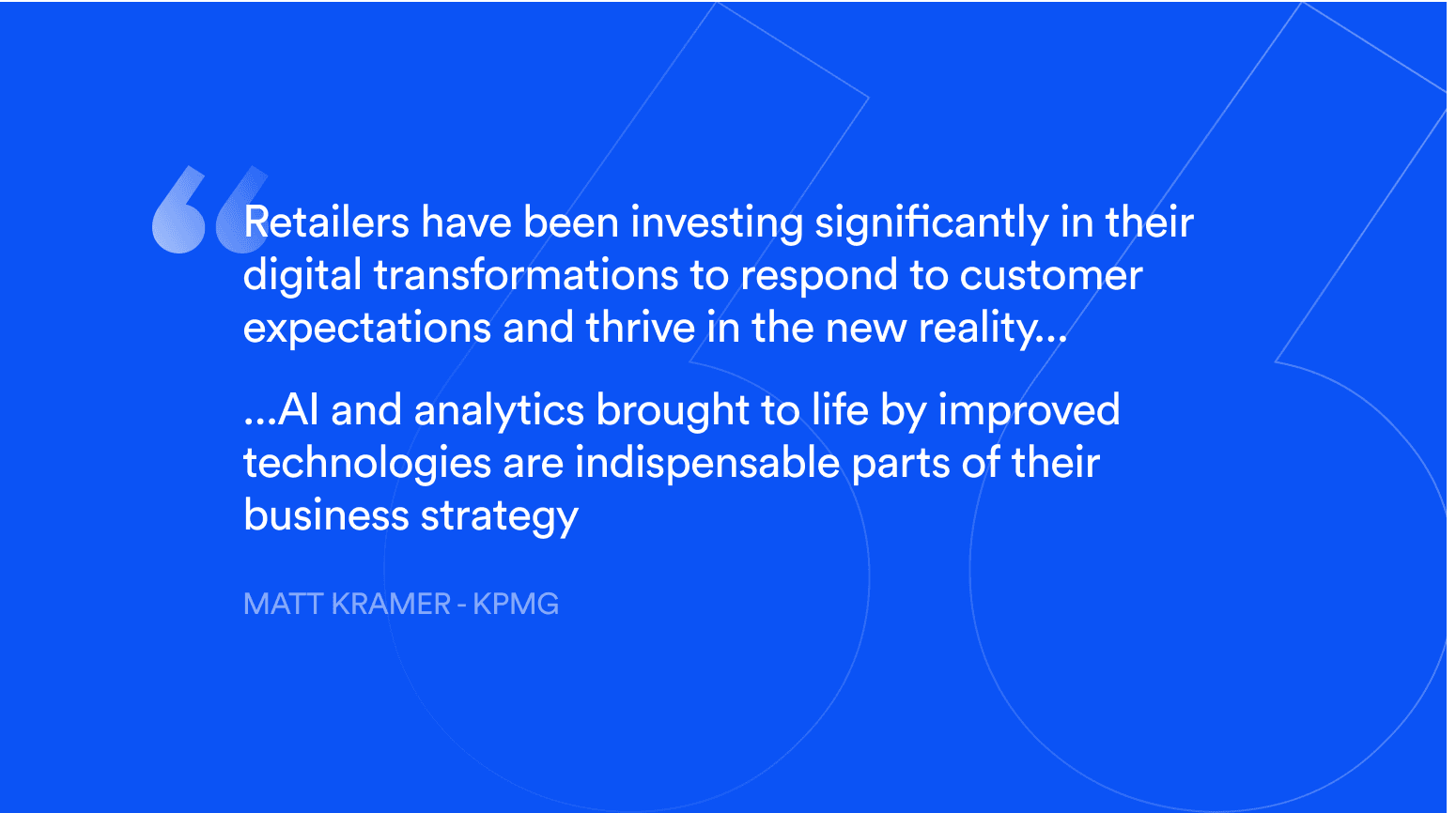
How can retailers keep up?
The global AI in the retail market was USD 3.75 billion in 2020. For the 2021-2028 period it’s expected to grow from $4.84 to $31.18 billion. As of today, there’s no indication that this trend will change.
Ongoing technological breakthroughs are powering the shift towards a more efficient and agile industry. What remains constant is focusing on delivering value to customers while reducing costs.
Technology opens up a whole new world of capabilities that otherwise would not be feasible due to time and money constraints. These capabilities await to be exploited, and retailers are not wasting time.
Education is critical; podcasts, webinars, and similar events are being held, where industry leaders discuss AI, Computer Vision, and its implications moving forward. Retailers have to set a measurable goal they want to achieve with the application of Artificial Intelligence.
The next step is to choose a team of experts with the ability to understand the particulars of a retailer’s data. This is because the quality and quantity of data are critical for the models to succeed. The experts work from there to create sophisticated applications that keep revolutionizing how retail operations are done.
The integration of AI and specifically Computer Vision into the infrastructure of a business stops being a matter of choice when avoiding it means falling behind the competition.
First things first: where’s the data coming from?
Computer Vision works on visual resources: videos and images. The different techniques that the technology employs (object identification, detection, and tracking, image segmentation, and classification, among others) can either transform the data for a set purpose or take it as is to extract information from it.
For in-store shopping, data is collected from camera feeds, allowing for countless visual analytics to improve customer engagement and management of inventory, to name a few. For online businesses, data comes from images and videos that require processing to showcase products and services.
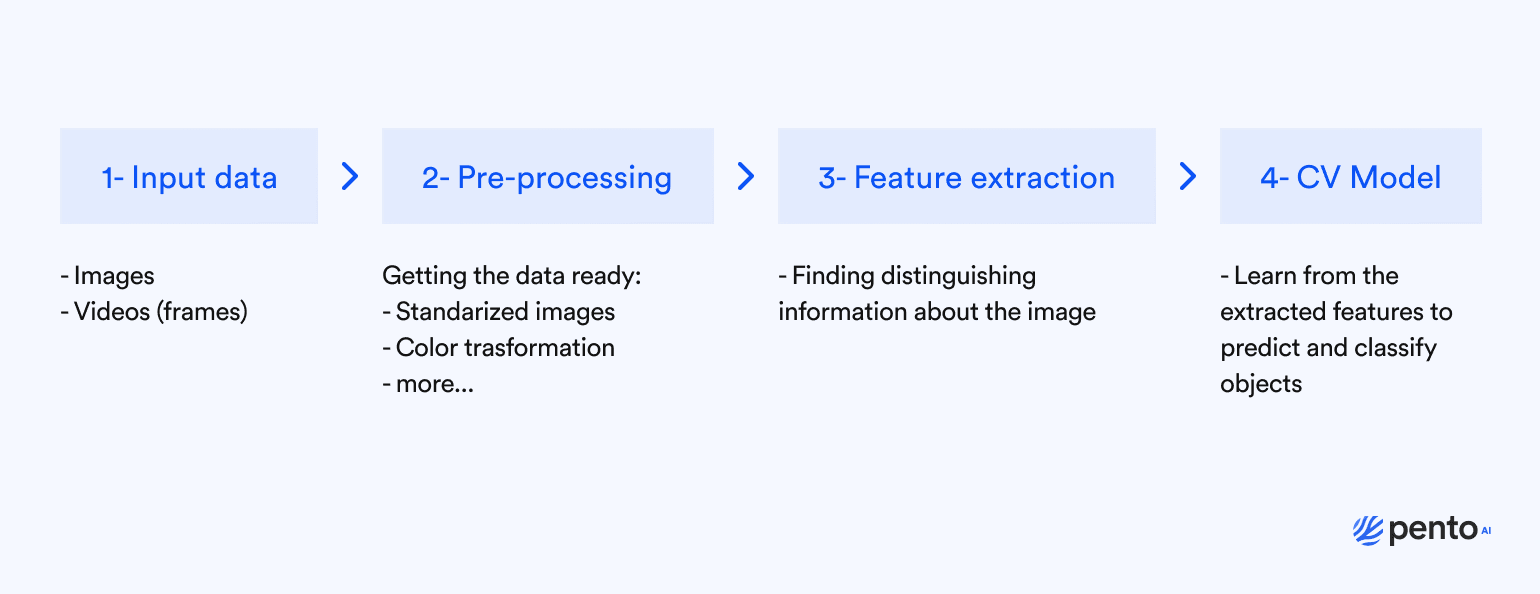
The general pipeline of the construction of a computer vision model.
Additionally, online and brick-and-mortar stores can collect massive amounts of data from the customer’s digital behavior according to their navigation patterns, preferences, and how they interact with the catalog of products.
This data is the input for the computer vision models for learning or training purposes. This means that the models use the data they’re fed to later use it as criteria for making decisions when faced with new data.
This way, based on what a model learned during training, it can provide an accurate output: the automation of a repetitive task, the classification of products by size, color, or the detection and tracking of a moving client around the store.
Our experience with the application of computer vision in retail
At Pento, we have had the opportunity to develop different frameworks for tackling the most diverse problems. Our clients come from various areas of the industry with very particular challenges.
The nature of the applications of Computer Vision is fairly different, but they all share the same purpose:
- Profit maximization
- Intelligent automation
- Eliminate cost inducing errors
- Benefit from concealed opportunities that lie on the data
- Increase customer engagement
Here is a list of some of the biggest return on the investment applications of Computer Vision in retail.
Computer vision: 7 applications in retail
1) Marketable images through automatic image retouching
Shopping as we knew it was deeply transformed by the pandemic. Trying on clothing, touching items, and inspecting them up close became an exception. Therefore, online shopping was catapulted, and the focus shifted to creating a smooth and natural online shopping experience.
Consignment companies are a clear example of the successful use of automatic image retouching. Thredup, What Goes Around Comes Around, and LXRandCo come to mind. This type of business receives large quantities of unique items and must process them into a final product that looks professional and attractive to buyers.
This translates to colossal amounts of images that require a great deal of time to accurately classify, retouch and label, among other tasks. Employing a team of humans for the whole process is highly costly and error-prone, making it impossible to be scalable.
To achieve images that depict products as closely as possible to reality, computer vision tools like automated image retouching and background removal are a must. It takes approximately 5 minutes for a professional to achieve a high-quality image. Automation through computer vision reduces it to a mere 10 seconds while allowing it to scale to thousands of image edition simultaneously.
SolidGrids is the perfect ally, not only for image retouching but also for fine-tuning images with advanced techniques to accurately represent a brand.
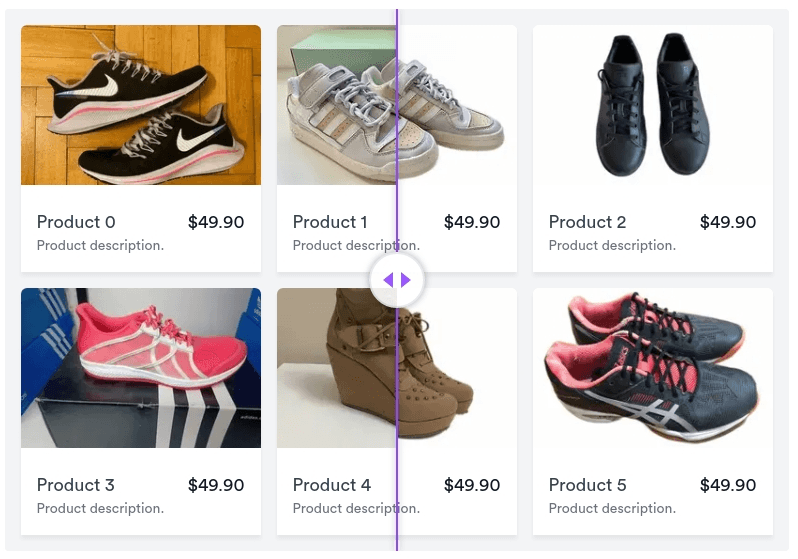
At Pento understand the importance of images ready for publication for the sales pipeline, and that's why we created this useful product. The benefits of implementing these tools outweigh the efforts by a high margin. It eliminates the excessive time and errors that inevitably occur when humans do the retouching.
Polished, alluring images in visually appealing catalogs significantly impact purchase intention. The frequency of product returns is also reduced when the customer is presented with an item that looks no different from its online aspect.
2) Computer Vision for Product discoverability
It’s helpful to think of the representation of a product in terms of its taxonomy and the category an image belongs to. Simply put, the taxonomy of an image refers to the attributes that make the image the way it is. Categories allow for the classification of an image according to certain criteria to enter that category.
The pictures of the dresses of a summer collection for a retail brand are composed of several attributes: fabric, color, length, silhouette. These characteristics come in handy for customers to filter by when looking for a specific kind of dress.
Suppose the attribute a customer prioritizes for their online search is not present in the image description. In that case, it probably won’t be found, and the customer won't move forward with the purchase. Here is where computer vision comes to save the day, being able to classify images based on their looks and not their tag.
3) Product recommendation through visual similarity
Product suggestions that go along with what’s already in a grocery shopping cart or a piece of clothing that might complete an outfit are examples of computer vision at retailers' service. It can go beyond and suggest items based on past purchases or a customer's style.
Computer vision models can represent the images in a way that searches by similarity are done seamlessly and fast, even when working with hefty amounts of data. This increases the likelihood of the shopper adding additional items to their cart and enhances the customer experience.
You can visit one of our recent blog posts for a more detailed take on this and embeddings specifically. The leading global fashion retailer Zara is not new to AI. Their ‘see similar’ button allows the shopper to continue exploring similar items, which is particularly useful when encountering an out-of-stock event. This aids in more natural navigation of the catalog and an overall positive shopping experience.
Our image recommender has dramatically improved the catalog navigation of a retailer client of ours who works with image galleries. They are currently reaping the benefits from this wise investment, and we continue working to better their operations.
Search engines and visual similarity work together
Visual search for online shopping is one of the fastest-growing trends in recent years. It’s critical to offer quality images that lead potential customers to the retailer. Social media is one powerful driver of trends, and even the most sophisticated customers use images they see online to search for similar items locally available and promote them online.
For this application, the aim is to understand what makes two products similar across different categories. It requires a powerful and detailed representation of the images. The computer vision models should be able to capture the right information to come back to it when comparisons are made.
The way the attributes relate to each other is an important key point for computer vision to provide accurate results. Similar items should appear as suggestions for the customer looking for summer dresses while going through the catalog. This raises the question of what exactly makes two dresses similar: it could be the silhouette, type of neck, length, or another attribute.
The precision with which these suggestions are made is critical, keeping in mind that it contributes to the customer experience. To approach these challenging problems, we stay up to date with the latest technology through continuous research to deliver the best solutions with computer vision for retailers.
If you’re interested in what we do and want to learn more, head to our blog, where our team shares page-turner posts and valuable resources.
4) Behavioral analytics with Computer Vision
When customers approach a store, they usually glance at the storefront, paying attention to specific items. Once inside, they may spend some time checking out products and then go on with their shopping. These are buying habits, and they hold great value when analyzed.
Computer vision analyzes these patterns and tracks the shopper traffic, extracting information that adds value to the store operations and marketing campaigns.
The technology can detect and classify the shoppers according to their demographics, discover areas with high shopper traffic and cold spots where products go unnoticed. Bottlenecks around the store could also be detected, along with long check-out lines that greatly affect the customer experience.
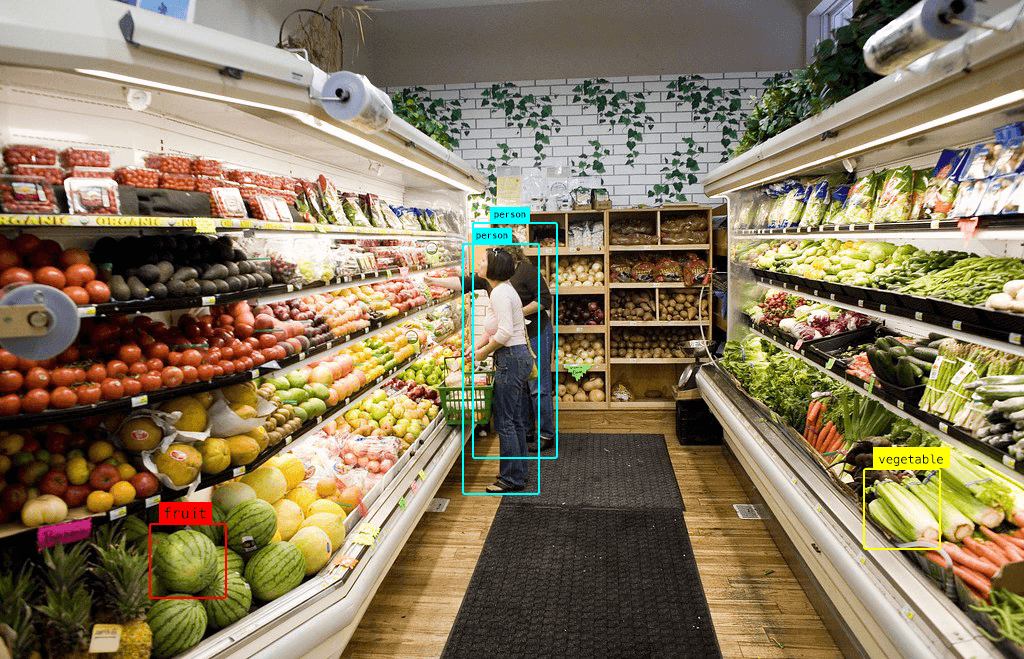
This analysis provides actionable insights that affect how retailers set their planograms to increase sell-through rates. What’s more, rigid marketing principles no longer dictate the timing for rolling out a line of products or how they are to be displayed. This is why this industry is increasingly adopting computer vision: the ability to learn from the customer and act accordingly.
Computer vision also provides theft behavior detection. The technology learns what constitutes it, recognizes it, and alerts staff accordingly.
5) Stock management with Computer Vision
Another vital part of any business is the efficient management of inventory. This involves many error-prone and time-consuming tasks, making it an excellent candidate for automation.
By feeding the system visual data from the shelves and building a robust dataset, computer vision can properly identify and classify items and quantities while also documenting every movement. Shelf analytics and records of historical sales trends help prevent stockouts and low on-shelf availability events.
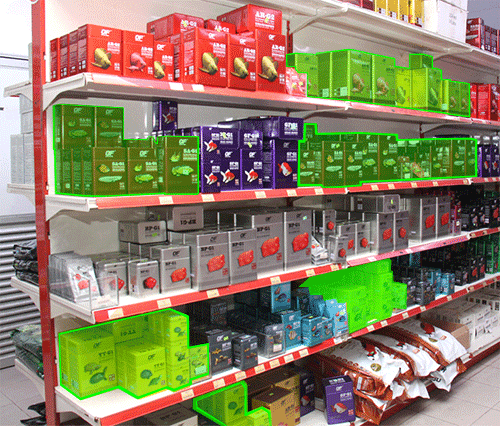
This application of computer vision in retail impacts the business in question and allows for the detection of possible supply chain issues. Ultimately, this also results in better use of personnel time, allowing employees to focus on more strategic tasks.
6) Price automation and optimization for profit maximization
This application is yet another example of tasks done by humans, basing the pricing decisions on factors that might not always be objective. With computer vision and price automation, retailers dispense with the staff who have to manually apply the price to each item, avoiding the enormous amount of time, errors, and money this takes.
Price automation is one of the most cost-effective machine learning applications in retail. Here computer vision plays a secondary role, with machine learning techniques as the core for pricing algorithms.
Price optimization is also important, given that prices are not static and are affected by shopping trends, holiday seasons, and supply and demand dynamics. Giving discounts when there’s high demand for a certain product is just as damaging for profits as keeping products at a permanently high price even if they have sold poorly.
Factors like the uniqueness of a product and what the competition is offering, are also considered when setting the best price for a particular item and a pricing strategy in general.
Increased productivity and scalability are other main advantages retailers benefit from when using computer vision to deal with the hassle of pricing. A price optimization strategy where the technology sets the prices and modifies them accordingly is a sure way not to lose on opportunities to maximize return on sales.
7) Cashierless stores exist thanks to computer vision
Amazon Go and Grabango are examples of computer vision and other machine learning techniques applied to create an innovative way of doing in-store shopping.
After authentication on the store’s app, shoppers can pick up the products they need (or put them back on the shelves) and then pay automatically when leaving the store. This involves facial recognition of the users, in-shelf sensors, smart carts, and cameras that track the items throughout the store.
Even though there are employees assisting those new to the experience, there is no need for traditional grocery store workers. The shopping experience is transformed: it eliminates lines and check-outs, saving valuable time for both the customer and the retailer.
Even though this is an application of computer vision in combination with other technology that may not apply to most retailers, it’s worth mentioning since it establishes a new benchmark for how shopping is done.
To close up
With the number of images and videos available increasing daily by the billion, and novel computer vision solutions tailored to a retailer's needs, there’s no end in sight for the solutions AI brings to the table.
Retailers already have the data by using in-store cameras and tracking online navigation paths.
The higher the amount of data the system scans and analyses, the greater its chances of producing far more accurate results for the business. By adopting a smart retail model, this data becomes a business asset that, once exploited, leads to well-thought-out strategies and growth.
The pandemic acted as a springboard for all technology-related tools. Forward-thinking retailers should adjust to this new reality and be prepared for similar dramatic events in the future. We say this because it’s essential to avoid uncertainty-related losses and explore new opportunities once AI is embedded in the operations and delivering value daily.
By now, it becomes clear that retailers should invest in AI solutions to keep up with demands and outperform the competition. As a CV consulting company, Pento's team has extensive experience in applied Computer Vision strategies for the retail world.
We understand our customers' needs and create tailored, innovative solutions while also providing continuous guidance and assessment.
If you want to know how to jump-start your computer vision journey, schedule a meeting with us, we are ready to help level up your business and take up our next challenge.